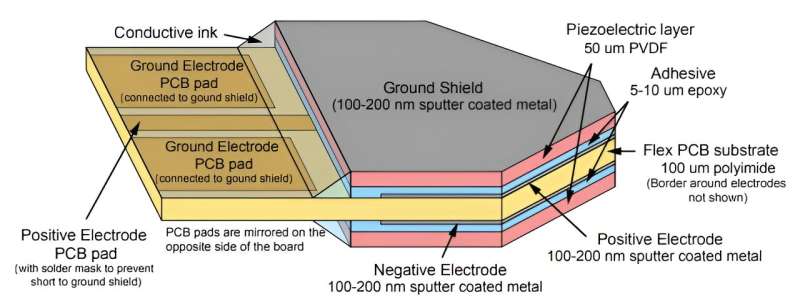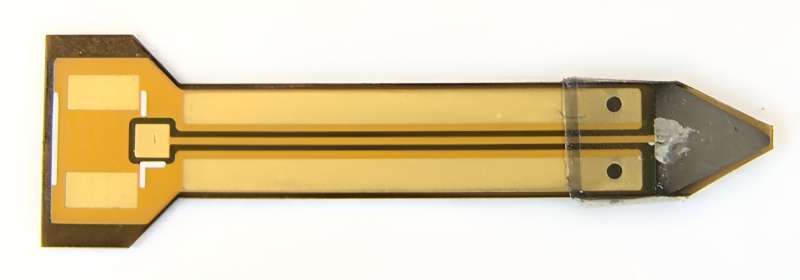This article has been reviewed according to Science X's editorial process and policies. Editors have highlighted the following attributes while ensuring the content's credibility:
fact-checked
peer-reviewed publication
trusted source
proofread
Implantable microphone could lead to fully internal cochlear implants

Cochlear implants, tiny electronic devices that can provide a sense of sound to people who are deaf or hard of hearing, have helped improve hearing for more than a million people worldwide, according to the National Institutes of Health.
However, cochlear implants today are only partially implanted, and they rely on external hardware that typically sits on the side of the head. These components restrict users, who can't, for instance, swim, exercise, or sleep while wearing the external unit, and they may cause others to forgo the implant altogether.
On the way to creating a fully internal cochlear implant, a multidisciplinary team of researchers at MIT, Massachusetts Eye and Ear, Harvard Medical School, and Columbia University has produced an implantable microphone that performs as well as commercial external hearing aid microphones. The microphone remains one of the largest roadblocks to adopting a fully internalized cochlear implant.
This tiny microphone, a sensor produced from a biocompatible piezoelectric material, measures miniscule movements on the underside of the ear drum. Piezoelectric materials generate an electric charge when compressed or stretched. To maximize the device's performance, the team also developed a low-noise amplifier that enhances the signal while minimizing noise from the electronics.
While many challenges must be overcome before such a microphone could be used with a cochlear implant, the collaborative team looks forward to further refining and testing this prototype, which builds off work begun at MIT and Mass Eye and Ear more than a decade ago.
"It starts with the ear doctors who are with this every day of the week, trying to improve people's hearing, recognizing a need, and bringing that need to us.
"If it weren't for this team collaboration, we wouldn't be where we are today," says Jeffrey Lang, the Vitesse Professor of Electrical Engineering, a member of the Research Laboratory of Electronics (RLE), and co-senior author of a paper on the microphone published in the Journal of Micromechanics and Microengineering.
Lang's co-authors include co-lead authors Emma Wawrzynek, an electrical engineering and computer science (EECS) graduate student, and Aaron Yeiser SM '21; as well as mechanical engineering graduate student John Zhang.
Other co-authors include Lukas Graf and Christopher McHugh of Mass Eye and Ear; Ioannis Kymissis, the Kenneth Brayer Professor of Electrical Engineering at Columbia; Elizabeth S. Olson, professor of biomedical engineering and auditory biophysics at Columbia; and co-senior author Hideko Heidi Nakajima, an associate professor of otolaryngology-head and neck surgery at Harvard Medical School and Mass Eye and Ear.
Overcoming an implant impasse
Cochlear implant microphones are usually placed on the side of the head, which means that users can't take advantage of noise filtering and sound localization cues provided by the structure of the outer ear.
Fully implantable microphones offer many advantages. But most devices currently in development, which sense sound under the skin or motion of middle ear bones, can struggle to capture soft sounds and wide frequencies.
For the new microphone, the team targeted a part of the middle ear called the umbo. The umbo vibrates unidirectionally (inward and outward), making it easier to sense these simple movements.
Although the umbo has the largest range of movement of the middle-ear bones, it only moves by a few nanometers. Developing a device to measure such diminutive vibrations presents its own challenges.
On top of that, any implantable sensor must be biocompatible and able to withstand the body's humid, dynamic environment without causing harm, which limits the materials that can be used.
"Our goal is that a surgeon implants this device at the same time as the cochlear implant and internalized processor, which means optimizing the surgery while working around the internal structures of the ear without disrupting any of the processes that go on in there," Wawrzynek says.
With careful engineering, the team overcame these challenges.

They created the UmboMic, a triangular, 3-millimeter by 3-millimeter motion sensor composed of two layers of a biocompatible piezoelectric material called polyvinylidene difluoride (PVDF). These PVDF layers are sandwiched on either side of a flexible printed circuit board (PCB), forming a microphone that is about the size of a grain of rice and 200 micrometers thick. (An average human hair is about 100 micrometers thick.)
The narrow tip of the UmboMic would be placed against the umbo. When the umbo vibrates and pushes against the piezoelectric material, the PVDF layers bend and generate electric charges, which are measured by electrodes in the PCB layer.
Amplifying performance
The team used a "PVDF sandwich" design to reduce noise. When the sensor is bent, one layer of PVDF produces a positive charge and the other produces a negative charge. Electrical interference adds to both equally, so taking the difference between the charges cancels out the noise.
Using PVDF provides many advantages, but the material made fabrication especially difficult. PVDF loses its piezoelectric properties when exposed to temperatures above around 80°C, yet very high temperatures are needed to vaporize and deposit titanium, another biocompatible material, onto the sensor. Wawrzynek worked around this problem by depositing the titanium gradually and employing a heat sink to cool the PVDF.
But developing the sensor was only half the battle—umbo vibrations are so tiny that the team needed to amplify the signal without introducing too much noise. When they couldn't find a suitable low-noise amplifier that also used very little power, they built their own.
With both prototypes in place, the researchers tested the UmboMic in human ear bones from cadavers and found that it had robust performance within the intensity and frequency range of human speech. The microphone and amplifier together also have a low noise floor, which means they could distinguish very quiet sounds from the overall noise level.
"One thing we saw that was really interesting is that the frequency response of the sensor is influenced by the anatomy of the ear we are experimenting on, because the umbo moves slightly differently in different people's ears," Wawrzynek says.
The researchers are preparing to launch live animal studies to further explore this finding. These experiments will also help them determine how the UmboMic responds to being implanted.
In addition, they are studying ways to encapsulate the sensor so it can remain in the body safely for up to 10 years but still be flexible enough to capture vibrations. Implants are often packaged in titanium, which would be too rigid for the UmboMic. They also plan to explore methods for mounting the UmboMic that won't introduce vibrations.
"The results in this paper show the necessary broad-band response and low noise needed to act as an acoustic sensor. This result is surprising, because the bandwidth and noise floor are so competitive with the commercial hearing aid microphone. This performance shows the promise of the approach, which should inspire others to adopt this concept.
"I would expect that smaller size sensing elements and lower power electronics would be needed for next generation devices to enhance ease of implantation and battery life issues," says Karl Grosh, professor of mechanical engineering at the University of Michigan, who was not involved with this work.
More information: Aaron Yeiser et al, The UmboMic: A PVDF Cantilever Microphone, Journal of Micromechanics and Microengineering (2024). DOI: 10.1088/1361-6439/ad5c6d. On arXiv: DOI: 10.48550/arxiv.2312.14339
This story is republished courtesy of MIT News (web.mit.edu/newsoffice/), a popular site that covers news about MIT research, innovation and teaching.





















